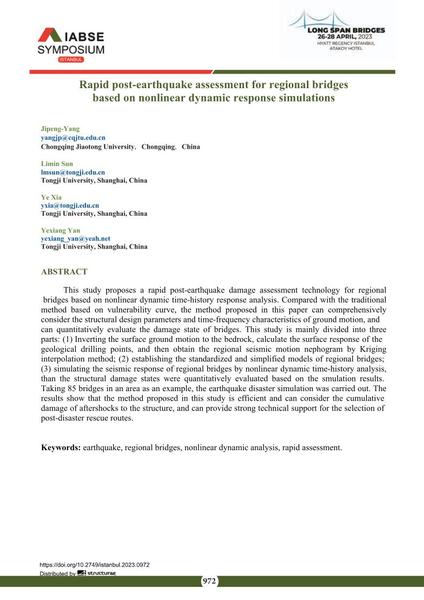Rapid post-earthquake assessment for regional bridges based on nonlinear dynamic response simulations

|
|
|||||||
Bibliographic Details
| Author(s): |
Jipeng-Yang
(Chongqing Jiaotong University,Chongqing,China)
Limin Sun (Tongji University, Shanghai, China) Ye Xia (Tongji University, Shanghai, China) Yexiang Yan (Tongji University, Shanghai, China) |
||||
|---|---|---|---|---|---|
| Medium: | conference paper | ||||
| Language(s): | English | ||||
| Conference: | IABSE Symposium: Long Span Bridges, Istanbul, Turkey, 26-28 April 2023 | ||||
| Published in: | IABSE Symposium Istanbul 2023 | ||||
|
|||||
| Page(s): | 972 | ||||
| Total no. of pages: | 1 | ||||
| Year: | 2023 | ||||
| DOI: | 10.2749/istanbul.2023.0972 | ||||
| Abstract: |
This study proposes a rapid post-earthquake damage assessment technology for regional bridges based on nonlinear dynamic time-history response analysis. Compared with the traditional method based on vulnerability curve, the method proposed in this paper can comprehensively consider the structural design parameters and time-frequency characteristics of ground motion, and can quantitatively evaluate the damage state of bridges. This study is mainly divided into three parts: (1) Inverting the surface ground motion to the bedrock, calculate the surface response of the geological drilling points, and then obtain the regional seismic motion nephogram by Kriging interpolation method; (2) establishing the standardized and simplified models of regional bridges; (3) simulating the seismic response of regional bridges by nonlinear dynamic time-history analysis, than the structural damage states were quantitatively evaluated based on the smulation results. Taking 85 bridges in an area as an example, the earthquake disaster simulation was carried out. The results show that the method proposed in this study is efficient and can consider the cumulative damage of aftershocks to the structure, and can provide strong technical support for the selection of post-disaster rescue routes. |
||||
| Keywords: |
earthquake non-linear dynamic analysis regional bridges rapid assessment
|
||||
